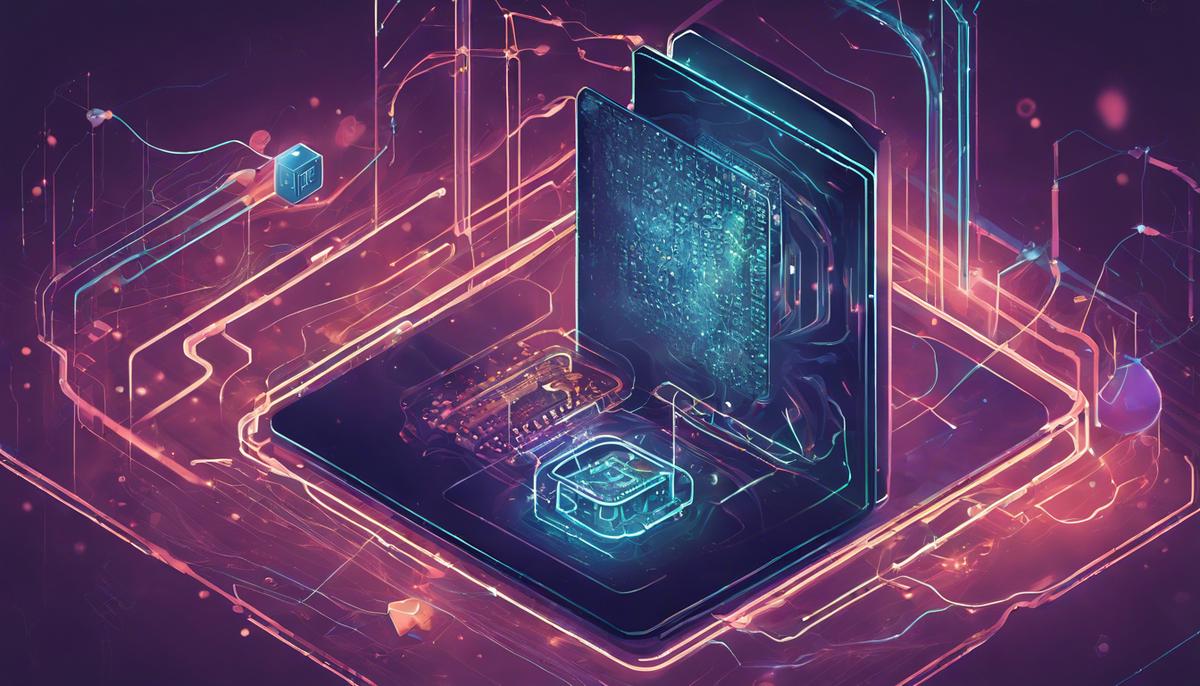The landscape of digital security and privacy is on the cusp of a significant transformation, driven by the advancements in quantum computing. This transition presents both unprecedented challenges and opportunities for the safeguarding of information in the digital age.
Quantum Computing Basics
Quantum Computing Basics
At the heart of quantum computing is the use of quantum mechanics to process information. The two key concepts are superposition and entanglement.
Superposition allows a quantum bit, or qubit, to be both 0 and 1 at the same time, unlike classical bits which are either 0 or 1. This enables quantum computers to process a vast amount of information simultaneously.
Entanglement is a phenomenon where the state of one qubit can depend on the state of another, regardless of the distance between them. This “spooky action at a distance” means operations on one entangled qubit instantly affect its partner, making quantum computing potentially powerful for tasks like cryptography and modeling complex systems.
These principles allow quantum computers to perform computations that would take classical computers an impractical amount of time. However, qubits are delicate and can lose their quantum state through decoherence. Quantum algorithms are also still in their early stages. Building a fully functional, error-resistant quantum computer remains a challenge that scientists and engineers are working to overcome.
The implications for cybersecurity are significant. The ability to perform rapid computations and potentially decipher current encryption methods places quantum computing at the forefront of technological advancements and future cybersecurity strategies. Progress in this field could redefine the timelines for “impossible” tasks and drive breakthroughs in securing or accessing data.
Understanding quantum computing is becoming increasingly important for anyone involved in the digital world, whether in securing data, developing new technologies, or staying informed about potential future developments.
Current Cybersecurity Protocols
Encryption is the cornerstone of contemporary cybersecurity, safeguarding digital information. Common encryption methods like RSA, ECC, and Diffie-Hellman ensure the confidentiality and integrity of data exchanged across the internet.
RSA encryption relies on the difficulty of factoring large prime numbers. While multiplying two large primes is easy, decomposing their product back into the original factors is computationally demanding for classical computers.
ECC provides security through the algebraic structure of elliptic curves over finite fields. It achieves encryption by leveraging the difficulty in solving the elliptic curve discrete logarithm problem. ECC can provide the same level of security as RSA with smaller key sizes, making it efficient and popular, especially in resource-constrained environments.
The Diffie-Hellman protocol enables secure key exchange over a public channel. It laid the foundation for public key cryptography, allowing two parties to establish a shared secret over an insecure medium.
Quantum computing poses a significant threat to these encryption protocols. Algorithms like Shor’s algorithm demonstrate the potential to break RSA and ECC encryption by drastically reducing the computational effort needed to factorize large numbers or solve discrete logarithm problems.
Moreover, quantum computing’s ability to quickly navigate complex problem spaces and identify patterns within large datasets could potentially compromise Diffie-Hellman’s key exchange mechanism.
The quantum era necessitates a reevaluation and revision of the cryptographic techniques that underpin our digital security infrastructure. While quantum computers capable of breaking today’s encryption may not be imminent, the principle of ‘harvest now, decrypt later’ highlights the need for ‘quantum-resistant’ encryption methods designed for long-term security.
Adopting post-quantum cryptography standards—methodologies believed to be secure against quantum computing—is not merely speculative but a necessary evolution. Ensuring digital information remains secure in the face of quantum developments requires a multidisciplinary approach that combines mathematical certainty with quantum uncertainty.
The path to protecting the integrity of our digital universe in a quantum world presents challenges but also opportunities to redefine encryption methods and strengthen our cybersecurity defenses.

Quantum Threat to Data Privacy
The potential vulnerability of modern encryption methodologies to quantum computing’s capabilities cannot be understated. The ‘harvest now, decrypt later’ strategy, where malicious actors collect encrypted data now with the expectation of decrypting it once quantum computers become available, poses a serious threat to data privacy.
Personal correspondences, corporate secrets, and national security measures could all be compromised if encryption methods are broken by quantum computing. Encrypted files thought to be secure for decades could potentially be decrypted with relative ease in the near future.
This necessitates a proactive response in developing quantum-resistant encryption technologies. Collaboration between cryptographers, quantum physicists, and policymakers is crucial to create an interdisciplinary defense against quantum vulnerabilities.
Embedding quantum-resilient mechanisms is a complex but critical task. It often requires a fundamental overhaul of cryptographic strategies rather than incremental adjustments. Delaying this process risks exposing sensitive data to quantum decryption capabilities.
Preserving trust in encrypted digital systems is paramount. A breach could have severe repercussions affecting financial stability, national security, and more. Our ability to outpace quantum advancements with cryptographically defensive innovations is crucial.
The quantum era also compels us to reassess our understanding of privacy and security. The assumptions underpinning current digital communications and transactions must evolve alongside quantum research. Anticipating and preparing for these needs will determine our level of defense or vulnerability.
The trajectory of quantum computing presents not only technical challenges but also fundamental questions about privacy, trust, and security within our digital infrastructure. As we navigate the post-quantum era, our vigilance and ingenuity in cryptography will define the boundaries of privacy and data security for individuals, corporations, and nations.
Fortifying our digital realms against the tide of quantum vulnerabilities is a collective calling. We must ensure that the revolutionary potential of quantum computing enhances rather than undermines the fabric of our society.
Post-Quantum Cryptography
Post-quantum cryptography represents a crucial turning point in safeguarding digital frontiers against quantum-capable adversaries. The development of encryption methodologies that can withstand the power of quantum computing is the focus of this field.
Organizations like the U.S. National Institute of Standards and Technology (NIST) are spearheading efforts to establish standards for post-quantum cryptographic algorithms. NIST has been evaluating submissions from cryptographers worldwide, each proposing quantum-resistant algorithms based on mathematical problems believed to be challenging for both classical and quantum processors.
After rigorous evaluation, four algorithms have emerged as the first wave of standardization in the quantum era. These involve:
- Lattice-based
- Code-based
- Multivariate polynomial
- Hash-based signature methodologies
Lattice-based cryptography, for example, relies on the presumed complexity of solving problems within lattice networks for quantum computers. Its resilience stems from the geometric nature of lattices, where finding the shortest vector becomes exponentially difficult as dimensions increase.1
‘Crypto agility’ is another key concept in post-quantum cryptography. It emphasizes designing systems with the flexibility to update cryptographic algorithms without substantial overhauls, allowing efficient transitions to more secure algorithms as threats evolve or vulnerabilities are discovered. This is particularly important in an era where quantum supremacy over classical encryption methods is a possibility.
The global cryptographic community’s pursuit of post-quantum cryptography involves challenges ranging from theoretical breakthroughs to practical implementation concerns. Each advancement in quantum-resistant algorithm development represents progress in securing our digital existence and a commitment to preserving the integrity of global information systems.
Post-quantum cryptography is a multidisciplinary field, combining mathematics, computer science, and quantum physics. It aims to create robust, quantum-proof digital sanctuaries.
Codifying post-quantum standards underpins a secure transition into the quantum computing epoch. It goes beyond a technical competition between computing paradigms and represents a dedication to anticipating future threats and opportunities while building defenses to safeguard digital communication and information storage against the quantum dawn.
By engaging with and understanding the principles and imperatives of post-quantum cryptography, society prepares itself for a resilient stride into the nuances and possibilities of the quantum age. It demonstrates our tireless drive for advancement, firmly rooted in the foundation of security.

Quantum Computing’s Dual-Use Potential
Quantum computing’s dual-use potential in cybersecurity presents a narrative of contrasts. Its prowess to undo current encryption paradigms equally heralds a new dawn for cybersecurity measures. Quantum computing’s capacity to fortify cybersecurity architectures holds a pivotal promise, catalyzing a renaissance in cryptographic methodologies while imbuing it with a profound dichotomy – it is both a harbinger of disruption and a bastion of digital fortification.
Quantum Key Distribution (QKD) is at the forefront of this fortification effort. QKD leverages quantum mechanics to establish a secure communication channel where any eavesdropping attempt can be detected immediately. It utilizes the principle that measuring a quantum system inherently alters its state, betraying any interloper’s presence. This intrusion detection mechanism, ingrained in the laws of physics, ushers in a novel archetype of secure communication, ostensibly impervious to even quantum-enabled adversaries.
Quantum-resistant encryption delineates another frontier where quantum computing plays a protective role. As organizations grapple with quantum-intensified threats, post-quantum cryptography offers a preemptive vanguard. These encryption algorithms rely on mathematical problems considered intractable even for quantum computers. Strategies under exploration include:
- Lattice-based constructions
- Multivariate quadratic equations
These strategies reflect diversity in confronting the quantum conundrum.
Beyond cryptography, quantum computing enables cybersecurity enhancements through simulations and modeling. Quantum computers can simulate complex systems with unparalleled fidelity, allowing professionals to model threats in high-resolution detail. By simulating attacks and defense mechanisms within the quantum paradigm, insights into vulnerabilities and countermeasures can be gleaned with precision, enabling a proactive posture against emerging threats.
However, the terrain of quantum cybersecurity is nascent and fraught with uncertainties spanning technical and ethical domains. The promise of impenetrable security is entwined with concerns around surveillance overreach and equitable access to quantum technologies. As we edge closer to realizing quantum computing’s dual-use potential in augmenting digital defenses, we must navigate the concomitant responsibilities with sagacity and foresight.
The odyssey into leveraging quantum computing for unraveling and reinforcing security fabrics is emblematic of our broader technological journey – marked by possibilities, challenges, and the quest for balance. The narrative of quantum computing’s dual-use potential in cybersecurity encapsulates a reflection on our endeavor to chart a course through the quantum age and harness this force as stewards of a secure digital future.

Preparing for a Quantum Future
Anticipating the advent of quantum computing necessitates a proactive organizational stance encompassing a holistic assessment of quantum vulnerability, strategic quantum readiness planning, and the adoption of a defense-in-depth cybersecurity approach.
Assessing quantum vulnerability involves:
- Identifying data most susceptible to quantum decryption
- Reviewing current security protocols’ cryptographic underpinnings
- Scrutinizing data longevity against potential quantum capabilities
Use-case analysis highlighting encrypted assets potentially at risk provides a roadmap for where quantum-proof strategies are indispensable.
Developing a quantum readiness strategy extends beyond preemptive cryptography tweaks. It interrogates the entire organizational infrastructure for quantum resilience, including transitioning to quantum-resistant algorithms, fostering crypto-agility, and weaving quantum awareness into corporate culture through education and training. Early involvement in Quantum Key Distribution (QKD) experiments, partnerships with quantum technology entities, and government-led initiatives yield insights and firsthand experience with cutting-edge defensive methodologies.
Adopting a defense-in-depth approach articulates a multilayered defense strategy interconnecting diverse security measures to protect data from various attack vectors quantum computing may exploit. This holistic perspective incorporates:
- Rigorous endpoint security
- Data encryption
- Access controls
- Network segmentation
- Continuous monitoring
Each layer provides redundant protection, aiming to mitigate risks associated with ‘harvest now, decrypt later’ attacks by minimizing encrypted data persistence and exposure.
Preparing for a quantum future entails advancing beyond prevailing security paradigms to integrate established and innovative cryptographic defenses. Organizations adopting a quantum readiness strategy, reinforced by a defense-in-depth approach, position themselves to guard against imminent quantum threats and chart a course leveraging quantum computing’s transformative potential in fortifying digital security infrastructures.
As we stand on the brink of this quantum frontier, embracing anticipation, preparedness, and adaptive evolution forms the cornerstone for navigating potential upheavals and heralding a securely encrypted future.

In conclusion, as we navigate the impending quantum era, developing and implementing quantum-resistant cryptographic methods is of paramount importance. This proactive approach is essential for ensuring the continued protection of digital information against the sophisticated capabilities of quantum computing.
Unleash the power of AI with Writio, the ultimate content writer for websites and blogs. This article was crafted by Writio.
Leave a Reply